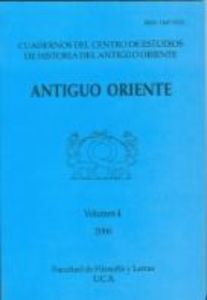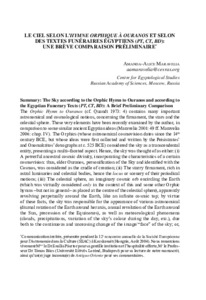Please use this identifier to cite or link to this item:
https://repositorio.uca.edu.ar/handle/123456789/11835| Título: | Le ciel se lon l’Hymne Orphique à Ouranos et se lon des textes funéraires égyptiens (PT, CT, BD):une brève comparaison préliminaire | Autor: | Maravelia, Amanda-Alice | Palabras clave: | COSMOGRAFIA; EGIPTOLOGIA; TEXTOS ANTIGUOS; HIMNOS | Fecha de publicación: | 2006 | Editorial: | Universidad Católica Argentina. Facultad de Filosofía y Letras. Centro de Estudios de Historia del Antiguo Oriente | Cita: | Maravelia, A.A. Le ciel se lon l’Hymne Orphique à Ouranos et se lon des textes funéraires égyptiens (PT, CT, BD): une brève comparaison préliminaire [en línea]. Antiguo Oriente. Cuadernos del Centro de Estudios de Historia del Antiguo Oriente. 2006 (4). Disponible en: https://repositorio.uca.edu.ar/handle/123456789/11835 | Resumen: | Summary: The Sky according to the Orphic Hymn to Ouranos and according to
the Egyptian Funerary Texts (PT, CT, BD): A Brief Preliminary Comparison
The Orphic Hymn to Ouranos (cf. Quandt 1973: 4) contains many
important
astronomical and cosmological notions, concerning the firmament, the stars and the
celestial sphere. These very
elements have been recently examined by the author, in
comparison to some similar ancient
Egyptian
ideas (Maravelia 2001: 49 ff. Maravelia
2006: chap. IV). The Orphics
(whose
astronomical
cosmovision dates since the 14th
century BCE, but whose ideas were first collected
and written
by the Peisistratos’
and Onomakritos’ doxographs at c. 525 BCE) considered
the sky as a transcendental
entity, presenting a multi–faceted aspect.
Hence, the sky was thought of as either:
(i)
A powerful ancestral cosmic divinity, incorporating
the characteristics
of a certain
cosmovision:
thus, elder Ouranos,
personification
of the Sky and identified with the
Cosmos, was considered
as the cradle of creation; (ii) The starry firmament,
rich in
astral luminaries and celestial bodies,
hence the locus or scenery
of their periodical
motions; (iii) The celestial
sphere, an imaginary cosmic orb encircling
the Earth
(which was virtually considered
only in the context of this and some other Orphic
hymns –but not in general– as placed
at the centre of the celestial sphere), apparently
revolving perpetually around the Earth, like an infinite cosmic top; by virtue
of these
facts, the sky was responsible for the appearance of various
astronomical
(diurnal rotation
of the Earth around her axis, annual revolution
of the Earth around
the Sun, precession
of the Equinoxes),
as well as meteorological
phenomena
(clouds, precipitations, variation
of the sky’s colour during the day, etc.), due
both to the continuous
and unceasing
change of the image/“face” of the sky; or, (iv) The guardian
and sacred
keeper of the Universal
Law, implying the celestial
harmony (connected to the Egyptian conception of Ma‘at). It has been proven (Krauss
1997; Wallin 2002; Maravelia 2006: chap. I, III, V) that the ancient
Egyptian funerary
texts were not only meant as religious compositions,
endeavoring
to safely transfer
the pharaohs and nobles from the visually perceived world to the metaphysical
realm
of the gods. They were also carriers of significant
astronomical
and cosmological
conceptions, expressed in a pre–scientific form, using myths and symbols
as virtual
signifiants. In the Pyramid Texts (PT), the Coffin Texts (CT), as well as in the Book
of the Dead (BD) there are numerous references to the sky. Either in the form of
the sky–goddess Nūt (in many instances personifying either the sarcophagus, as an
amniotic cocoon
for the deceased, or the Galaxy), or as the conception of the starry
firmament [biA(y)t] and the celestial
sphere [pDt, Hr(y)t], the notion of the sky plays
also an important part in these (religious
and cosmographical)
texts, which could be
classified –mutatis mutandis– under some of the same
previous categories
[viz (ii)
and (iv), supra]. Resumen: El cielo según el Himno Órfico a Urano y según los textos funerarios egipcios (TP, TS, LM): una breve comparación preliminar El Himno Órfico a Urano (Quandt 1973: 4) contiene varias e importantes nociones astronómicas y cosmológicas, relativas al firmamento, las estrellas y la esfera celestial. Estos elementos han sido examinados por la autora recientemente, comparándolos con algunas ideas egipcias similares (Maravelia 2001: 49 ss.; Maravelia 2006: cap. IV). Los órficos (cuya cosmovisión astronómica data del siglo XIV a.C., pero cuyas ideas fueron por primera vez recopiladas y escritas por los doxógrafos de Pisístrato y de Onomácrito hacia c. 525 a.C.) consideraban el cielo como una entidad trascendente, que presentaba un aspecto multifacético. Por lo tanto, el cielo era pensado como: (i) una divinidad cósmica poderosa y ancestral, incorporando las características de una cierta cosmovisión: así, el anciano Urano, personificación del Cielo e identificado con el Cosmos, fue considerado como la cuna de la creación; (ii) el firmamento estrellado, rico en luminarias astrales y cuerpos celestes, por lo tanto el locus o escenario de sus movimientos periódicos; (iii) la esfera celeste, un orbe cósmico imaginario que rodeaba la Tierra (que fue considerada virtualmente sólo en el contexto de éste y algunos otros himnos órficos –pero no en general– como ubicada en el centro de la esfera celeste), aparentemente orbitando de modo perpetuo alrededor de la Tierra, como un trompo cósmico infinito; a causa de estos hechos, el cielo era responsable de la aparición de varios fenómenos astronómicos (la rotación diurna de la Tierra alrededor de su eje, la revolución anual de la Tierra alrededor del Sol, la precesión de los Equinoccios) y meteorológicos (nubes, precipitaciones, variaciones del color del cielo durante el día, etc.), debido al continuo e incesante cambio de la imagen /“rostro” del cielo; o (iv) el guardián y cuidador sagrado de la Ley Universal, que implicaba la armonía celestial (conectada con la concepción egipcia de Ma’at). Se ha comprobado (Krauss 1997; Wallin 2002; Maravelia 2006: caps. I, III, V) que los antiguos textos funerarios egipcios no eran únicamente entendidos como composiciones religiosas, concebidos para transportar de modo seguro a los faraones y los nobles del mundo percibido visualmente al reino metafísico de los dioses. Eran además portadores de significativas concepciones astronómicas y cosmológicas, expresadas de un modo pre–científico, utilizando mitos y símbolos como significantes virtuales. En los Textos de las Pirámides (TP), en los Textos de los Sarcófagos (TS), así como en el Libro de los Muertos (LM), hay numerosas referencias al cielo. Sea en la forma de la diosa del cielo Nūt (en varias instancias personificada por el sarcófago, como un caparazón amniótico para el muerto, o la Galaxia) o como la concepción del firmamento estrellado [biA(y)t] y la esfera celestial [pDt, Hr(y)t], la noción del cielo juega también una parte importante en estos textos (religiosos y cosmográficos) que podrían ser clasificados –mutatis mutandis– bajo algunas de las categorías previas [viz (ii) y (iv), supra]. |
URI: | https://repositorio.uca.edu.ar/handle/123456789/11835 | ISSN: | 1667-9202 | Disciplina: | HISTORIA | Derechos: | Acceso abierto | Fuente: | Antiguo Oriente. Cuadernos del Centro de Estudios de Historia del Antiguo Oriente No.4, 2006 |
| Appears in Collections: | AO - 2006 nro.4 |
Files in This Item:
| File | Description | Size | Format | |
|---|---|---|---|---|
| antiguo_oriente04.pdf.jpg | 3,75 kB | JPEG |  View/Open | |
| ciel-selon-hymne.pdf | 462,97 kB | Adobe PDF |  View/Open |
Page view(s)
88
checked on Apr 27, 2024
Download(s)
148
checked on Apr 27, 2024
Google ScholarTM
Check
This item is licensed under a Creative Commons License

